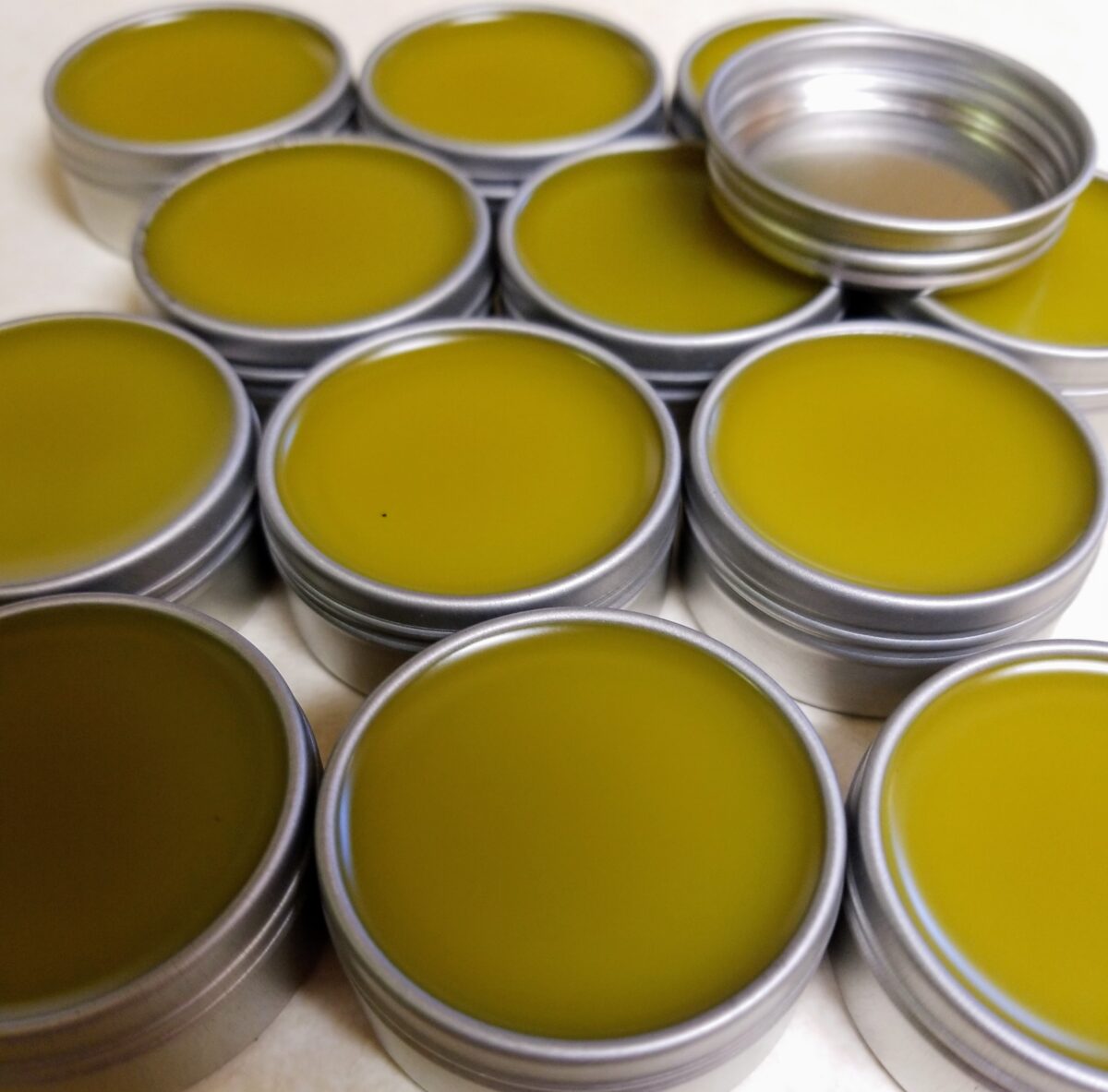A salve like this one should be applied to the skin, directly on the spot showing symptoms of an infection.
When we create recipes we do our best to use herbs that are readily available to all, which means using herbs that can be found in grocery stores, or harvested from local woods and urban green spaces. That means our recipes are changing constantly as different herbs come into season. If you are trying to recreate this salve and cannot get all the herbs listed, that’s okay, you can replace them with other herbs that have the same properties or even leave a few out completely.
Ingredients
- ½ Cup of Mock Bishop’s weed
- ½ Cup Mint
- ½ Cup Senna Alata
- 1 tsp whole Cloves
- 1 tsp Vitamin E
- 5 drops of Lavender oil
- 2 drops Lemongrass oil
- 10 drops of Tea Tree Oil
- Extra Virgin Olive oil (for infusing herbs)
- 1 Cup Beeswax
- 1 Cup Shea Butter
Infused Herbs
These herbs were infused in olive oil for four weeks, a simple process that pulls the medicinal ingredients out of the plant matter and into the oil. The oil was then used to make the salve.
Mock Bishopweed
Other common names: Threadleaf / Herbwilliam
Like Bishop’s Weed, a related plant in the same family, this plant acts to treat skin conditions like psoriasis, tinea versicolor (a fungus caused by excess yeast), vitiligo, and eczema.
Senna Alata
This plant is known to help treat skin conditions like ringworm, tinea infections, scabies, blotch, herpes, and eczema.
More info on Senna Alta [nih.gov]
Mint
This well known herb acts to soothe, cool, hydrate and nourish skin. It acts to relieve itchiness and pain, fights damage from aging, prevents infections by killing problematic bacteria and disease causing microorganisms on the skin, fades acne scars, boosts collagen production (skin elasticity), fights damage from sun exposure, and improves skin elasticity.
Cloves
Cloves are known to decrease swelling and pain. The plant is also a strong antimicrobial, meaning it protects against or destroys microscopic organisms, bacteria, and viruses that cause infection.
More info on clove [webmd.com]
Essential Oils
Essential oils are the volatile oils of certain aromatic or strong smelling herbs. It takes a lot of herbs to make a small bottle so they are somewhat expensive and not always sustainable. We use them in small amounts in salves and other topical remedies to make them smell good.
Volatile oils do have medicinal properties which are often quite strong, however, they are not necessary to make most effective herbal remedies.
Lavender Oil
This essential oil soothes swelling, irritation, and redness. It also works to prevent infections by killing problematic bacteria, fungus, and disease causing microorganisms. It’s also known to help with skin conditions like eczema, psoriasis, and acne.
More info on lavender [webmd.com]
More info on lavender [healthline.com]
Lemongrass Oil
This essential oil acts to heal wounds, fight fungi and problematic bacteria, and reduce pain and inflammation
More info on lemongrass [healthline.com]
Tea Tree Oil
Another essential oil that soothes dry skin by reducing itching and irritation. It also works to prevent infections by killing problematic bacteria, fungus, and disease causing microorganisms. It has been shown to help with eczema, psoriasis, and acne.
More info on tea tree oil skin benefits [healthline.com]
More info on tea tree oil and ringworm [healthline.com]
Oils and Waxes
These oils and waxes make up the base of the salve (what makes it cream like).
Vitamin E Oil
Vitamin E is an essential nutrient and is a skin moisturizer. It’s also a natural antioxidant and is used as a stabilizer to help the salve last longer.
Beeswax
Beeswax acts to prevent the growth of yeasts and other fungi and helps keep things clean by creating a seal and reducing risk of contamination. This makes it a common ingredient in skin treatments and salves.
Olive Oil and Shea Butter
Both are most commonly used to moisturize skin but also contain many other helpful properties that reduce inflammation, fight the effects of aging on the skin, and prevent skin cancers.
Other Antifungal Plants
These are other antifungal plants you may use to substitute any of the ingredients you may be unable to find in this recipe.
Liu, Q., Meng, X., Li, Y., Zhao, C. N., Tang, G. Y., & Li, H. B. (2017). Antibacterial and Antifungal Activities of Spices. International journal of molecular sciences, 18(6), 1283. https://doi.org/10.3390/ijms18061283
Mishra,K. K., Kaur, C.D., Sahu, A.K., Panik, R., Kashyap, P., Mishra, S. P., and Dutta, s. (2020). Medicinal Plants Having Antifungal Properties. DOI: 10.5772/intechopen.90674
Avocado Leaves
Mishra et. al.
Eastern Black Walnut
Ho, K. V., Lei, Z., Sumner, L. W., Coggeshall, M. V., Hsieh, H. Y., Stewart, G. C., & Lin, C. H. (2018). Identifying Antibacterial Compounds in Black Walnuts (Juglans nigra) Using a Metabolomics Approach. Metabolites, 8(4), 58. https://doi.org/10.3390/metabo8040058
Garlic
Bayan, L., Koulivand, P. H., & Gorji, A. (2014). Garlic: a review of potential therapeutic effects. Avicenna journal of phytomedicine, 4(1), 1–14.
Ginger Root
Mishra et. al.
Goldenseal
Goldenseal: Uses, side effects, interactions, dosages, and warning;
Guava (leaves)
Mishra et. al.
Mexican Sunflower (whole plant)
Mishra et. al.
Olive (leaves and olive fruits)
Hashmi, M. A., Khan, A., Hanif, M., Farooq, U., & Perveen, S. (2015). Traditional Uses, Phytochemistry, and Pharmacology of Olea europaea (Olive). Evidence-based complementary and alternative medicine : eCAM, 2015, 541591. https://doi.org/10.1155/2015/541591
Pink Trumpet Tree (Pau D’arco)
Pau D’Arco Medicinal Uses
Purple Shamrock (Leaves)
Mishra et. al.
Turmeric
Murugesh, J., Annigeri, R. G., Mangala, G. K., Mythily, P. H., & Chandrakala, J. (2019). Evaluation of the antifungal efficacy of different concentrations of Curcuma longa on Candida albicans: An in vitro study. Journal of oral and maxillofacial pathology : JOMFP, 23(2), 305. https://doi.org/10.4103/jomfp.JOMFP_200_18

